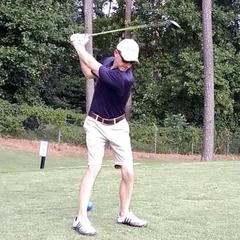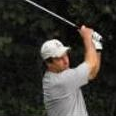-
Posts
580 -
Joined
-
Last visited
-
Days Won
4
Adam C last won the day on August 7 2021
Adam C had the most liked content!
About Adam C

Personal Information
-
Your Location
Atlanta
Your Golf Game
- Index: 4
- Plays: Righty
Recent Profile Visitors
Adam C's Achievements
-
I have not done any bore through videos on my channel. Assume there won't be much of an audience but I might need to add it to the list of up comers. Other tip since you have to use the adapter, dry fit everything together and get the shaft lined up at the correct depth, then wrap 4 or 5 layers of masking tape on the shaft right above (touching) the top of the adapter. This will keep you from over inserting the shaft or having the shaft slip further down during epoxying.
-
My ears were burning. Been busy busy recently but since I've done over 100 bore thru clubs thought this was a good time to check back in. Callaway is pretty straight forward in general. Did not see what model you are dealing with. Important because some of the later ones had a collared adapter style ferrule that you needed to use. If it's just a standard O ring model, then no problem there. You can either pre cut the shaft tip at the appropriate angle before assembly or cut it after epoxy is dry. Either works. Also need some graphite shaft pins to seal the vent hole in the shaft. As for cutting the shaft, I usually recommend a hacksaw if you are doing the cutting after epoxy and then sanding it flush. I always got the shaft evened off with the club sole and then went back to shaft pin the vent hole. Once that is dry, hacksaw and sand again to get the stub of the pin flat and even. Final step, brush with acetone just like turning a ferrule. Be aware, the shaft is going to play a bit stiffer then it would with a traditional hosel club. Now if you'll excuse me I need to go measure some lie angles with my $1.95 Sharpie!!
-

Left- vs. Right-Handed Driver Adapter
Adam C replied to cdh79's topic in Clubs, Grips, Shafts, Fitting
Yup. You've got it right. Lie is lie, no change there. Loft you just need to reverse in your head so higher is lower and vise versa. Mizuno uses a 2 degree sleeve essentially, so lowest loft setting on a 9.5 degree head will be 11.5 etc etc. -

Putter Adjustment Help Needed
Adam C replied to wakefield724's topic in Clubs, Grips, Shafts, Fitting
Never bent this model but I don't see any reason it can't be done by someone who knows what they're doing (aka not Dicks in general). It's also not a hosel, it's a stem mount if that tells you anything about the info you were given. -

SIM 2 Max Irons - KBS or True Temper Shaft?
Adam C replied to NoMoreSlices's topic in Clubs, Grips, Shafts, Fitting
Plenty of good points on here. If you do in fact just seem to do better with lighter weight, I will offer this one point. KBS has a bit of history with their lower weight class steel shafts bending at the tip. This becomes more of an issue when you pair it with faster swings. I might lean towards the TT Elevate shaft for that simple reason since the weight and profile are pretty similar. -
Don't worry about SF. Trackman is trying to measure ball data and club head data at the same time. It can have difficulty measuring the club speed because of how and where it tries to measure from depending on the driver head design. The radar always has some issues with it. That often leads to inaccurate club head speeds and therefore inaccurate smash factor numbers. Just focus on ball speeds, that is what matters.
-

Shaft Weight Relationship to Flex
Adam C replied to woodzie264's topic in Clubs, Grips, Shafts, Fitting
So the 55g CB shaft has the 8g plug in the butt end of it. It also has a heavier head weight to match up with that. That heavier head will make the shaft feel softer during the swing regardless of what shaft you put in it. You might want to try installing lighter head weights into it and removing the 8g plug just to see what happens as this will stiffen up the shaft a bit. The Alta CB is a very good shaft, quality wise, so I might try this before moving away from it. If nothing else it should be a cheaper experiment than a reshaft. -

Shaft Weight Relationship to Flex
Adam C replied to woodzie264's topic in Clubs, Grips, Shafts, Fitting
I would need to know exactly what shaft you had in both the G and the 425 before I could recommend anything. Just as a side note, a "whippy" shaft by itself will not lose the ball right for a RH golfer. The feel of that shaft may influence the golfer in a way that causes them to leave the face open, but it's an important distinction when deciding on shafts to realize it's not the shaft itself that is hanging open. -

Theory - All Clubs Should Have the Same Lie Angle?
Adam C replied to iacas's topic in Clubs, Grips, Shafts, Fitting
If you think this theory is true then it should be extremely easy to test. Either get on GEARS and check the lies of your longest and shortest irons, or go find a GC4 or Trackman and do the same. And if you don't have easy access to those, might I suggest the sharpie line check 😀.- 39 replies
-
- lie angle
- shaft droop
-
(and 3 more)
Tagged with:
-

Theory - All Clubs Should Have the Same Lie Angle?
Adam C replied to iacas's topic in Clubs, Grips, Shafts, Fitting
Not saying the "average person" is buying the GEARS set up, the average person buys access to the technology that otherwise would be unavailable to them. Here's an experiment. Go check the lie angle question that started this thread using GEARS, and then cross check those results with the sharpie check. See how the results compare.- 39 replies
-
- lie angle
- shaft droop
-
(and 3 more)
Tagged with:
-

Theory - All Clubs Should Have the Same Lie Angle?
Adam C replied to iacas's topic in Clubs, Grips, Shafts, Fitting
Hmmm. Actually it would be more accurate to say the FBI has been using DNA for years, but now average people can buy the same tools and use them to solve crimes at home. Not saying don't use GEARS for any number of swing investigations. It will provide information to the average golfer they otherwise would never have access to. But the idea that all the shaft and club OEMs have completely missed the mark on the idea of lie angle is far fetched.- 39 replies
-
- lie angle
- shaft droop
-
(and 3 more)
Tagged with:
-

Theory - All Clubs Should Have the Same Lie Angle?
Adam C replied to iacas's topic in Clubs, Grips, Shafts, Fitting
This information isn't new. True Temper was measuring shaft bend in 3 dimensions almost 30 years ago via Shaft Lab. Fujikura has been utilizing ENZO since 2013. GC2 and GC4 can also provide this info and have been around for a number of years.- 39 replies
-
- lie angle
- shaft droop
-
(and 3 more)
Tagged with:
-

Theory - All Clubs Should Have the Same Lie Angle?
Adam C replied to iacas's topic in Clubs, Grips, Shafts, Fitting
No one needs to argue about anything here. Again, just go check your own clubs with a sharpie line and you can decide if you need the lie angles adjusted within a tighter progression or simply 1 lie angle to rule them all, or no change at all.- 39 replies
-
- lie angle
- shaft droop
-
(and 3 more)
Tagged with:
-

Theory - All Clubs Should Have the Same Lie Angle?
Adam C replied to iacas's topic in Clubs, Grips, Shafts, Fitting
I am sure the GEARS system is great for a number of things but when it comes to lie angle it's not necessary. Also we should probably take a cue from the OEMs who have and continue to make iron sets with progressive lie angles. Trust me when I say that they have a very complete understanding of shaft droop and all other forces acting on a golf club. If this was something with merit that could lead to selling more equipment, they would be all over it as they are pretty desperate for new features and benefits on modern equipment. Also, I do recommend people check every lie angle in their set. It's so simple and accurate, no reason not to spend 15 minutes on the range and check everything.- 39 replies
-
- lie angle
- shaft droop
-
(and 3 more)
Tagged with:
-

Theory - All Clubs Should Have the Same Lie Angle?
Adam C replied to iacas's topic in Clubs, Grips, Shafts, Fitting
Sure, this could be the case for some people but is most certainly not the case for all. Having fit and adjusted more than a few golfers, I can't say I've seen this play out this way. But if you are really thinking this could be the case for you (ie an individual golfer), just check your lie angles of your PW, 7, and 4 or 5 iron with the vertical line check and see if you do in fact see your lie angles being off.- 39 replies
-
- lie angle
- shaft droop
-
(and 3 more)
Tagged with:








